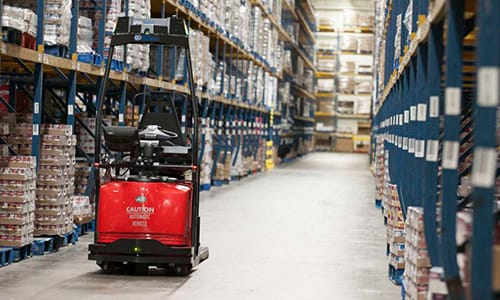From Labor Shortages to Productivity Gains: The Rise of Collaborative Robotics
- share

Discover how collaborative robots (cobots) help warehouses overcome labor shortages by boosting efficiency, reducing costs, and empowering workers—creating smarter, safer, and more productive operations.
In warehouses and distribution centers across the country, one challenge continues to dominate conversations: how to meet rising demand with a limited workforce. Labor shortages, turnover, and the physical strain of repetitive tasks have left many facilities struggling to keep pace. Recruiting and retaining talent is harder than ever, while customer expectations for speed and accuracy continue to rise.
That’s where collaborative robots—or “cobots”—come in. Unlike traditional automation that fully replaces human roles, cobots are designed to work alongside people, complementing rather than competing with the workforce. By handling repetitive, time-consuming, or physically demanding tasks, cobots free up employees to focus on higher-value work, improving both efficiency and job satisfaction.
What Makes Cobots Different?
The material handling industry has long embraced automation—conveyors, automated guided vehicles (AGVs), and robotic arms are now common. But cobots mark a shift in philosophy. They are:
- Flexible: Easily integrated into existing workflows without major infrastructure changes.
- Adaptive: Scalable for peak seasons or fluctuating demand.
- Collaborative: Built to operate safely in close proximity with humans, with intuitive interfaces and responsive navigation.
Rather than asking, “How do we replace people?” cobots answer, “How do we make people’s jobs easier, safer, and more productive?”
Real-World Applications in Warehousing
- Order Picking & Transport: Solutions like Locus Robotics, deployed through Werres, enable autonomous robots to travel long distances in the warehouse while employees remain in their picking zones. This simple shift can reduce worker travel time by up to 90%.
- Repetitive Movement Relief: Instead of walking miles a day, employees focus on accuracy and quality control, while cobots handle the heavy lifting and long hauls.
- Improved Throughput: Facilities integrating cobots have seen significant productivity gains during peak demand periods—without adding headcount.
The outcome isn’t fewer jobs; it’s better jobs—roles that keep workers engaged, reduce burnout, and make warehouse operations more sustainable long-term.
The Business Case for Cobots
- Scalability: Deploy cobots quickly to handle seasonal spikes or growth without the lag time of hiring and training.
- Cost Savings: Lower overtime, fewer injuries from repetitive tasks, and improved workflow efficiency all contribute to the bottom line.
- Employee Satisfaction: Workers are less likely to leave when their jobs are less physically taxing and more meaningful.
By optimizing human effort and robotic support, facilities can boost output, maintain safety, and ensure customers receive faster, more accurate fulfillment.
What’s Next for Cobots?
The role of cobots is only expanding. As artificial intelligence, machine learning, and warehouse management systems (WMS) evolve, cobots will become even smarter—optimizing routes in real time, integrating with wearable tech to track operator fatigue, and pairing with augmented reality tools to accelerate training.
In the near future, we won’t be talking about whether to adopt cobots but rather how many and where they fit best within each operation.
Partnering with Werres for Smarter Automation
At Werres, we believe that automation works best when it’s designed to support people. That’s why we partner with leading solutions like Locus Robotics to bring practical, scalable cobot technology to warehouses and distribution centers across the region.
If your facility is ready to explore how cobots can reduce labor pressures and unlock new levels of productivity, visit our Systems & Automation solutions page or connect with our team to start the conversation.


